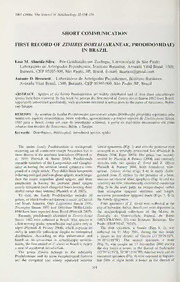
First Record Of Zimiris doriai (Araneae, Prodidomidae) In Brazil PDF
Preview First Record Of Zimiris doriai (Araneae, Prodidomidae) In Brazil
2007 (2008). The Journal ofArachnology 35:554-556 SHORT COMMUNICATION FIRST RECORD OF ZIMIRIS DORIAI (ARANEAE, PRODIDOMIDAE) IN BRAZIL Lina M. Almeida-Silva: P6s Graduagao em Zoologia, Universidade de Sao Paulo. Laboratorio de Artropodes Pegonhentos, Institute Butantan. Avenida Vital Brasil, 1500, Butanta, CEP 05503-900, Sao Paulo, SP, Brazil E-mail: lmamas(ggmaiLcom Antonio D. Brescovit: Laboratorio de Artropodes Pegonhentos, Institute Butantan. Avenida Vital Brasil, 1500, Butanta, CEP 05503-900, Sao Paulo, SP, Brazil ABSTRACT. Spiders of the family Prodidomidae are widely distributed and at least three synanthropic species have been reported. In thisworkwe present thefirst record ofZimirisdoriaiSimon 1882from Brazil, appartentlyintroducedaccidentally,withspecimensrecordedinurbanareasinthestatesofAmazonas, Bahia, and Sergipe. RESUMO. As aranhas da familia Prodidomidae apresentam ampia distribuigao geograficaepossuempelo menos tres especies sinantropicas. Neste trabalho, apresentamos o primeiro registro de Zimiris doriai Simon 1882 para o Brasil, como um caso de introdugao acidental, a partir de especimes encontrados em areas urbanas dos estados do Amazonas, Bahia, e Sergipe. Keywords: Distribution, Neotropical, introduced species, spider The spider family Prodidomidae is widespread, lateral spinnerets (Fig. 2) and also the posterior eyes occurring on all continents except Antarctica but is arranged in a strongly procurved line (Platnick & more diverse in the southern hemisphere (Platnick et Penney 2004; Jager 2005). The genus was recently al. 2005; Platnick & Baehr 2006). Prodidomids revised by Platnick & Penney (2004) and currently resemble members ofthe Lamponidae and Gnapho- includes only two species Z. doriai and Z. diffusa sidae in having the anterior lateral spinnerets com- Platnick & Penney 2004, both considered wide- posed ofa single article. They differ from lamponids spread. Zimiris doriai (Figs. 1^) is easily distin- inhavingenlargedpiriformglandspigots,muchlarger guished from Z. diffusa by the presence of a bent, than the major ampullate gland spigots, and from sinuous retrolateral tibial apophysis (Fig. 6) and the gnaphosids in having the piriform gland spigots relatively narrow, retrolaterally excavated conductor greatlyelongated (withelongated bases bearing short (Fig. 5) in the male palp; an omega-shaped rather shafts) ratherthan widened (Platnick et al. 2005). than triangular epigynal midpiece and longer, To date, the family Prodidomidae includes 30 narrower paramedian epigynal ducts (Figs. 7, 8) in genera,ofwhichtwelveareknowntooccurinCentral the female epigynum.. and South America. Only Lygromma Simon 1893, Four specimens ofZ. doriai were collected in the Tricongius Simon 1893 and Oltadoea Mello-Leitao city ofSalvador, Bahia, Brazil and were deposited in 1940 have been reported from Brazil (Platnick 2007). the arachnological collections of the Museu de Recently, prodidomids identified as Zimiris doriai Zoologia da Universidade Federal da Bahia Simon 1882 were collected in Brazil. This species is (MZUFBA2066; 32) and Institute Butantan, Sao afastmovingspider, synanthropicand activeonlyat Paulo (IBSP70242; 70243). night (Platnick & Penney 2004), which explains its The first specimen, a female (Figs. 1, 2), was rarity in scientific collections despite its widespread collected on 11 May 2004, during the day inside distribution. According to this information and a house in the district of Garcia (12°59'29.92"S, based on its occurrence in synanthropic environ- 38°30'12,91"W). The second specimen, a male ments, the first record ofZ. doriaiin Brazil is clearly (Fig. 3), was caught on 17 November 2005 during a case ofaccidental introduction. the day inside a house, in the district of Federagao The genus Zimiris belongs to the subfamily (12°59N2.91"S, 38°30d2.91"W).Anothermaleandan Prodidominae and its main morphological features immaturespecimen(Fig. 4)werecapturedin Septem- are the elongated and widely separated anterior ber 2006 at night inside a house in the district of 554 ALMEIDA-SILVA & BRESCOVIT—ZIMIRIS IN BRAZIL 555 — Figures 1-4. Zimiris doriai: 1. Female; 2. Details ofspinnerets; 3. Male; 4. Immature. Photographs 1, 2, and 4 by Agustin Camacho. Cabula (12°56'10.45"S, 38°27'54.98"W). Comparing MSgrant#135760/2006-2andADBPQ301776/2004- these specimens with other prodidomids of the 0)and FAPESP(FundagaodeAmparoaPesquisado arachnoiogicalcollectionofIBSP, wedetected anoth- EstadodeSaoPaulogrant06/05453-0;99/05446-8)for erthree females that were collectedin urban environ- financial support. We also thank Cristina A. Rheims ments.TwofemaleswerecollectedinManaus(2°54'S, for helpful suggestions on the manuscript, Agustin 59°58'W), Amazonas (IBSP13883; 23705) inside the CamachoforthephotosandTaniaBrazilfortheloan lodgingsoftheReservaFlorestalAdolphoDuckeand of specimens of the UFBA collection. This work is thethird wasfound in thecity ofAracaju (1°27'21"S, part of BIOTA/FAPESP - The Biodiversity Virtual 48°30'14"W), state ofSergipe (IBSP7516). Institute Program (www.biotasp.org.br). Zimiris doriai seems to be more widespread than Z. diffusa, which is restricted to the Old World. The LITERATURE CITED latter must have been accidentally introduced in Jager, P. 2005. Zimiris doriai (Araneae: Prodidomi- many countries of that region. Zimiris doriai has dae) - erstmals nach Deutschland eingeschleppt. been previously reported from India, Cuba, Mexico, Arachnologisches Mitteilungen 29:17-19. Yemen, Eritreia, Sudan, Dominican Republic, Ivory Platnick, N.I. 2007. The World Spider Catalog, Coast, French Guiana, Malaysia, Java, Massawa version 7.0. American Museum ofNatural Histo- (Platnick & Penny2004), Germany(Jager2005), and ry, NewYork. Onlineat http://research.amnh.org/ now in Brazil. entomology/spiders/catalog/index.html. ACKNOWLEDGMENTS Platnick, N.I. & B. Baehr. 2006. A revision of the Australasian ground spiders of the family Prodi- We wish to thank CNPq (Conselho Nacional do domidae(Araneae: Gnaphosoidea). Bulletinofthe Desenvolvimento Cientifico e Tecnologico, LMAS American Museum ofNatural History 298:1-287. — 556 THE JOURNAL OF ARACHNOLOGY Figures 5-8. Zimiris doriai: 5. Left male palpus, ventral view; 6. Left male palpus, retrolateral view; 7, Epigynum, ventral view; 8. Epigynum dorsal view. Scale; 0.5 mm. Platnick, N.I. & D. Penney. 2004. A revision ofthe (Araneae, Gnaphosoidea), with a revision of the widespread spider genus Zimiris (Araneae, Prodi- genus Moreno Mello-Leitao. American Museum domidae). American Museum Novitates 3450: Novitates 3499:1-31. - 1 12. Platnick, N.L, M.U. Shadab& L.N. Sorkin. 2005. On Manuscript received 12 April 2007, revised 27 June the Chilean spiders of the family Prodidomidae 2007.
